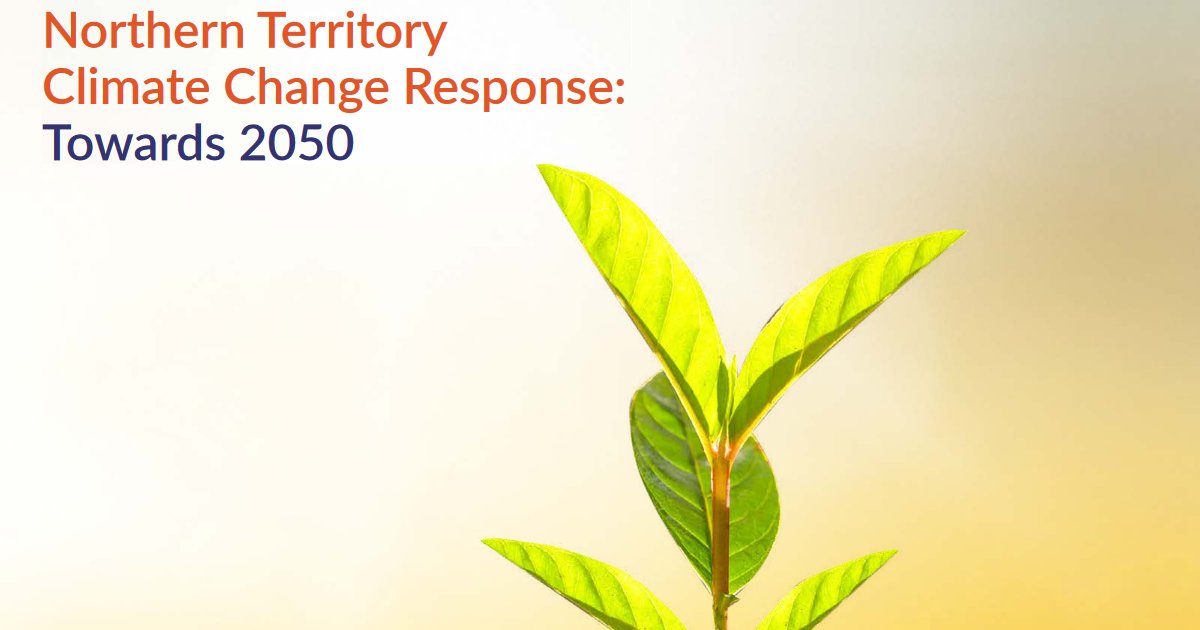
Previously an aspirational target, the NT has committed to achieving net zero emissions by 2050. But there are some devils lurking in the detail.
Following a draft released in September last year, yesterday the Territory Labor Government released its “Climate Change Response: Towards 2050” document and a three-year action plan; which are built around 4 key objectives
- Slashing emissions to achieve net zero emissions by 2050
- Building a resilient Territory that adapts and responds to the impacts of climate change
- Unlocking opportunities from a low-carbon future
- Informing and involving all Territorians in the climate change response.
While the response document states solar energy is the cheapest form of electricity generation, it doesn’t get a specific mention in the three-year plan. However, the three-year plan notes it will deliver priority actions to achieve the 50% renewable energy target by 2030, and solar power is the centrepiece of that.
Climate Council CEO Amanda McKenzie welcomed the move, stating every Australian state and territory has now adopted a net-zero target, meaning we have a de facto national net-zero target.
“The national net-zero target is a message to all investors. Australia will be out of fossil fuels by 2050,” said Ms. McKenzie.
The NT Government could have other ideas.
What About Fracking Gas?
In April 2018, Northern Territory Chief Minister Michael Gunner announced his government would proceed with permitting fracking of onshore unconventional shale gas reservoirs in the NT, ending a moratorium on the activity. In June last year, the Code of Practice for the NT’s onshore gas industry was finalised; opening the door to a bunch of related emissions. It hasn’t been a smooth road since for fracking hopefuls, with recent world events creating uncertainty. But the potential remains.
On the topic of NT gas in general, Ms. McKenzie said.
“I would also implore the NT government not to develop any new gas projects. Net-zero emissions can only be achieved by ending fossil fuel developments.”
The Gunner Government believes otherwise. Also released yesterday was its Offsets Policy.
The accompanying news release notes:
“The Offsets Framework will be used to guide decisions related to environmental impacts only when they cannot be avoided or reduced to an appropriate level. For example, to offset greenhouse gas emissions produced by a project, actions can be undertaken at an alternate location to reduce the project’s emissions.”
“A project” provides plenty of wiggle room and the release notes the Offsets Framework aligns with the Government’s Scientific Inquiry into Hydraulic Fracturing in the Northern Territory.

 RSS - Posts
RSS - Posts



The Independent Planning Commission NSW (IPCN) is currently determining whether to approve or reject the proposed Vickery Extension Project.
See: https://www.ipcn.nsw.gov.au/projects/2020/03/vickery-extension-project
On July 2 (Day 1) and 3 (Day 2), the IPCN conducted electronic public hearings for registered speakers wishing to speak on the matter. Today, the IPCN published the transcripts for these electronic public hearings.
Climate scientist Professor Will Steffen spoke on Day 2, with statements that included (on transcript page 27):
“To cut this – cut right to the quick here, 1.5 degrees Celsius is now impossible.” …
“The upper Paris target of well below two, which I take as around 1.8, is barely possible but only if we make immediate and deep emission cuts aiming to cut our emissions in half by 2030 – that’s a 50 per cent reduction – and eliminate them by 2040. Net zero by 2050 is too late.”
See: https://www.ipcn.nsw.gov.au/resources/pac/media/files/pac/transcripts-and-material/2020/vickery/200703-vickery-extension-project–public-hearing-day-2-transcript.pdf
I’d suggest the scientific evidence (per Steffen) is indicating that the NT target for “Slashing emissions to achieve net zero emissions by 2050” is too late and inadequate.
Climate Council CEO Amanda McKenzie is quoted as saying: “Australia will be out of fossil fuels by 2050.”
I’d suggest Australia needs to be out of all fossil fuels by 2040.
The article above states:
“In June last year, the Code of Practice for the NT’s onshore gas industry was finalised; opening the door to a bunch of related emissions. It hasn’t been a smooth road since for fracking hopefuls, with recent world events creating uncertainty. But the potential remains.”
The Independent Planning Commission NSW (IPCN) is currently determining whether to approve or reject the proposed Narrabri CSG Project.
See: https://www.ipcn.nsw.gov.au/projects/2020/03/narrabri-gas-project
On July 15, the IPCN issued a press release including:
“The state’s Independent Planning Commission will hear from a record number of interested stakeholders when it conducts an electronic Public Hearing into the contentious Narrabri Gas Project next week.
The virtual event will allow those for and against the $3.6 billion coal seam gas project to present their views to Commissioners Steve O’Connor (Panel Chair), John Hann and Professor Snow Barlow prior to them making a final decision.
Four hundred and four people (404) have registered to speak at the hearing, which will be extended from five to seven days to ensure everyone gets to have their say. The electronic Public Hearing will be held from Monday 20 July to Saturday 25 July, and on Saturday 1 August commencing at 9.30am AEST daily.”
See: https://www.ipcn.nsw.gov.au/resources/pac/media/files/pac/general/200715narrabri-gas-project-public-hearingfinal.pdf?la=en&hash=31A26E0AB3140185BD4266224B3E3C55
I’d suggest there is clear evidence of strongly held public sentiment (at least in NSW) against more gas projects, based on the enormous number of submissions already published by the IPCN objecting to this CSG project.
Meanwhile, Australia’s lucrative exports of natural gas are being hit hard by a global gas supply glut and the coronavirus crisis destroying demand, with dozens of cargoes either anchored offshore or idling at sea as Asian buyers delay deliveries.
See: https://www.smh.com.au/business/the-economy/australia-s-lng-tankers-sitting-idle-as-global-supply-glut-covid-start-to-bite-20200615-p552oh.html
Also: https://www.smh.com.au/business/the-economy/sailing-around-in-circles-lng-tankers-idle-at-sea-as-buyers-delay-cargoes-20200716-p55cou.html
Like the NSW government is finding with the proposed Narrabri CSG Project, the NT government may also find a strong public sentiment against fracking of onshore unconventional shale gas reservoirs in the NT.